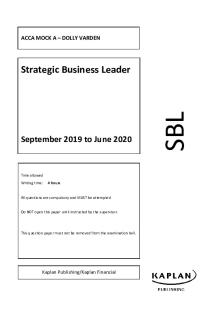mock Test 1 in bib PDF

| Title | mock Test 1 in bib |
|---|---|
| Course | Buyer and Consumer Behaviour |
| Institution | University of South Australia |
| Pages | 2 |
| File Size | 96.2 KB |
| File Type | |
| Total Downloads | 70 |
| Total Views | 147 |
Summary
test 1...
Description
Mark:
Buyer Behaviour Insights MARK 5032 Test 1
/10
Grade:
Name: ______________________________________________________________________ Student ID: __________________________________________________________________
1. Which of the following ‘Schools of Inquiry’ (or ‘Schools of Thought’) focuses most on explanation rather than prediction? Interpretivism Market Modelling Behaviourism Cognitivism
A B C D
2. Which model of consumer decision treats purchasing as behaviour learned in response to aspects of the consumers situation? Cognitive Model Reinforcement Model Situational Model Habit Model
A B C D
3. Are solely loyal buyers of a brand heavy, light or average buyers of the category? Heavy buyers Light buyers Neither heavy nor light (average) buyers
A B C
4. In subscription markets… 100% loyalty is the norm Customers switch between brands at least half yearly Polygamous loyalty is the norm Consumers regularly shuffle between brands
A B C D
5. Which of the following combinations represents what makes a good empirical generalisation? Scope, Scope, Scope, Scope,
Page 1 of 2
Precision, Precision, Precision, Precision,
Parsimony, Usefulness, Link with theory Parsimony, Usefulness, Not linked with theory Complexity, Usefulness, Link with theory Complexity, Usefulness, Not linked with theory
For revision purposes only
A B C D
6. Which of the following is NOT a principle of data reduction in relation to table presentation: Results should be rounded to show two significant figures Brands should be presented in alphabetical order An average / total row should be included at the bottom of the table Any unnecessary table lines should be removed
A B C D
7. Which of the following concepts focuses on the idea of learning through ‘trial and error’? Brand recognition Classical conditioning Operant/ instrumental conditioning Double jeopardy
A B C D
8. Which of the following is the most likely explanation for smaller repertoire sizes The social class of the buyer Limited brand availability Attitudinal and behavioural commitment to the brand Limited finances of the buyer
A B C D
9. Polygamous loyalty means that buyers: Shuffle around between the brands in their repertoire Are not attitudinally loyal to any single brand Truly switch to another brand, unlikely to re-purchase the original brand Are solely loyal to a single brand
A B C D
10. Share of Category Requirements is a brand performance metric which measures: How big your brand is How often on average your buyers have bought your brand The proportion of people that have bought your brand at least once The proportion of your buyer’s total category purchases devoted to your brand
Page 2 of 2
For revision purposes only
A B C D...
Similar Free PDFs

mock Test 1 in bib
- 2 Pages

Grand MOCK TEST 2 - mock test
- 11 Pages

Mock test con risposte
- 8 Pages

Mock Exam C250 - Mock test questions
- 34 Pages

SBL Mock Test 2020-21
- 22 Pages

MCQ Optical Fiber mock test
- 11 Pages

HMc Daniel Annotated Bib
- 6 Pages

Oriel Mock Numeracy Test Answers
- 3 Pages

SBL Mock Test 2020-21
- 22 Pages

Mat mock test paper 2
- 11 Pages

SBL MOCK EXAM 1
- 16 Pages

Persuasive Outline & Bib
- 6 Pages

POLITICS 106 MOCK 1
- 3 Pages

Electromagnetism Mock Exam 1
- 1 Pages

Mock 1 Perceptual Acuity
- 7 Pages
Popular Institutions
- Tinajero National High School - Annex
- Politeknik Caltex Riau
- Yokohama City University
- SGT University
- University of Al-Qadisiyah
- Divine Word College of Vigan
- Techniek College Rotterdam
- Universidade de Santiago
- Universiti Teknologi MARA Cawangan Johor Kampus Pasir Gudang
- Poltekkes Kemenkes Yogyakarta
- Baguio City National High School
- Colegio san marcos
- preparatoria uno
- Centro de Bachillerato Tecnológico Industrial y de Servicios No. 107
- Dalian Maritime University
- Quang Trung Secondary School
- Colegio Tecnológico en Informática
- Corporación Regional de Educación Superior
- Grupo CEDVA
- Dar Al Uloom University
- Centro de Estudios Preuniversitarios de la Universidad Nacional de Ingeniería
- 上智大学
- Aakash International School, Nuna Majara
- San Felipe Neri Catholic School
- Kang Chiao International School - New Taipei City
- Misamis Occidental National High School
- Institución Educativa Escuela Normal Juan Ladrilleros
- Kolehiyo ng Pantukan
- Batanes State College
- Instituto Continental
- Sekolah Menengah Kejuruan Kesehatan Kaltara (Tarakan)
- Colegio de La Inmaculada Concepcion - Cebu
